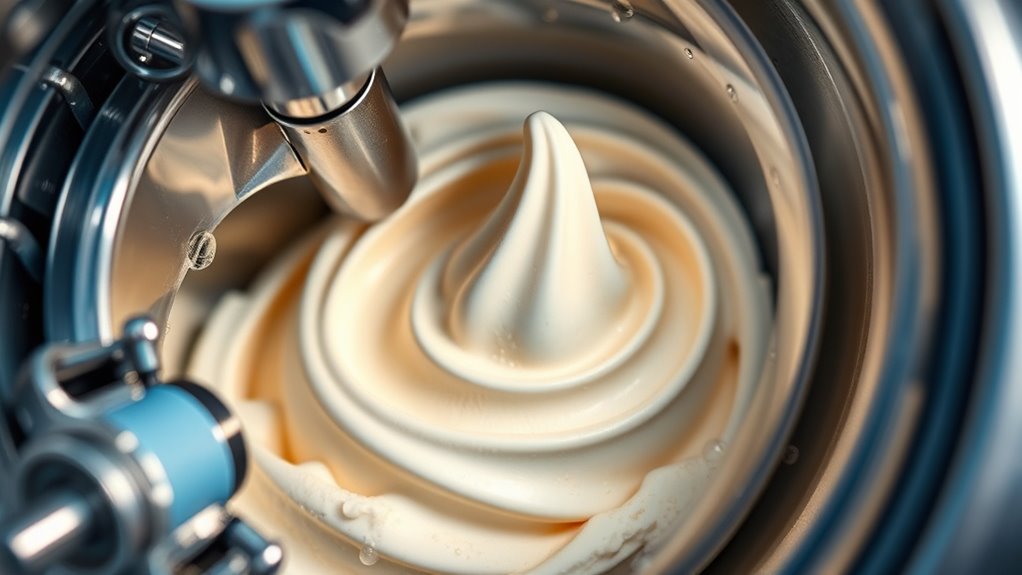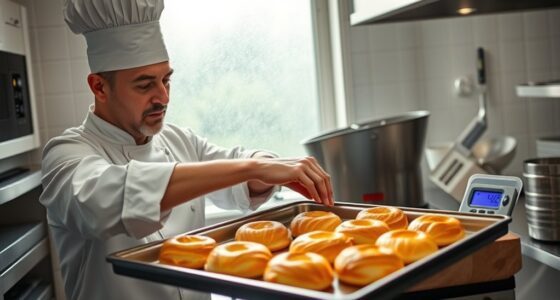The science behind ice cream machines involves precisely controlling thermodynamics, heat transfer, and agitation to create that smooth, creamy texture you love. Effective cooling methods remove heat evenly, preventing large ice crystals, while agitation distributes these crystals for a velvety mouthfeel. Modern innovations streamline flavor infusion and consistency, thanks to advanced cooling and automation. Curious to discover how these scientific secrets work together to produce perfect ice cream? Keep exploring to uncover the fascinating details.
Key Takeaways
- Ice cream machines utilize heat transfer principles like conduction and convection to control freezing rates and prevent large ice crystal formation.
- Agitation during freezing distributes ice crystals evenly and incorporates air, enhancing texture and creaminess.
- Advanced cooling systems maintain optimal temperatures, ensuring rapid freezing and small crystal growth for smooth textures.
- Modern innovations enable precise flavor infusion and consistent mix-in incorporation without compromising texture.
- Proper management of physical and chemical properties, such as sugar crystallization and flavor chemistry, optimizes ice cream quality.
The Role of Thermodynamics in Ice Cream Production
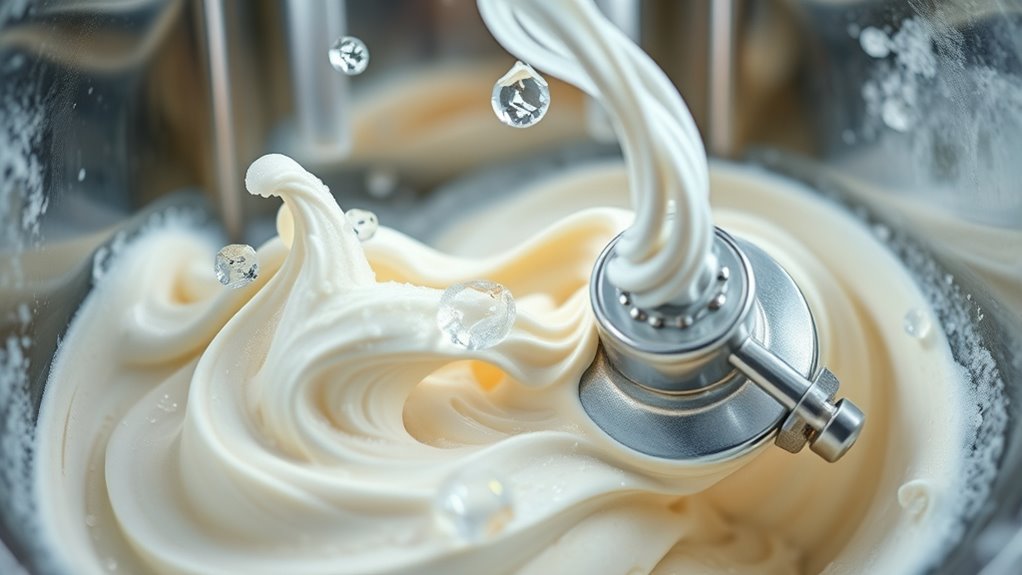
Thermodynamics plays a crucial role in ice cream production by controlling how heat moves during the freezing process. When your mixture cools, it undergoes phase transitions from liquid to solid. Understanding heat transfer is essential because it determines how quickly and evenly the ice cream freezes. As heat is extracted, the temperature drops, causing water molecules to change state, forming ice crystals. Proper management of this heat transfer ensures a smooth texture and prevents large ice crystals that can ruin quality. The principles of thermodynamics help optimize the freezing process, balancing the rate of heat removal with the need to maintain the mixture’s stability. By regulating heat flow during phase transitions, manufacturers produce creamy, consistent ice cream every time.
How Chilling and Freezing Techniques Work

Chilling and freezing techniques are essential for turning liquid mixtures into smooth, solid ice cream. These methods rely on heat transfer, removing energy from the mixture to reach freezing temperatures. As the temperature drops, ice crystals form, giving ice cream its texture. During sublimation, ice shifts directly from solid to vapor without melting, which can affect quality if uncontrolled. Effective cooling ensures uniform freezing, preventing large crystals. Imagine a table where heat moves from the mixture to the cold environment:
| Heat Transfer Method | Effect on Ice Cream |
|---|---|
| Conduction | Direct contact cooling, quick freeze |
| Convection | Air circulation for even cooling |
| Sublimation | Vapor loss, potential quality issue |
| Radiation | Less significant in ice cream making |
These techniques work together to produce the perfect consistency. Understanding the importance of contrast ratio can help optimize the freezing process for better texture and clarity. Additionally, proper control of temperature regulation is vital to achieve the ideal ice crystal size for a smooth finish. Proper heat transfer methods are vital to ensure the ice cream develops the desired structure and mouthfeel. Moreover, awareness of AI security vulnerabilities is crucial to prevent potential issues in automated ice cream production systems that rely on AI technology.
The Mechanics of Agitation and Texture Development
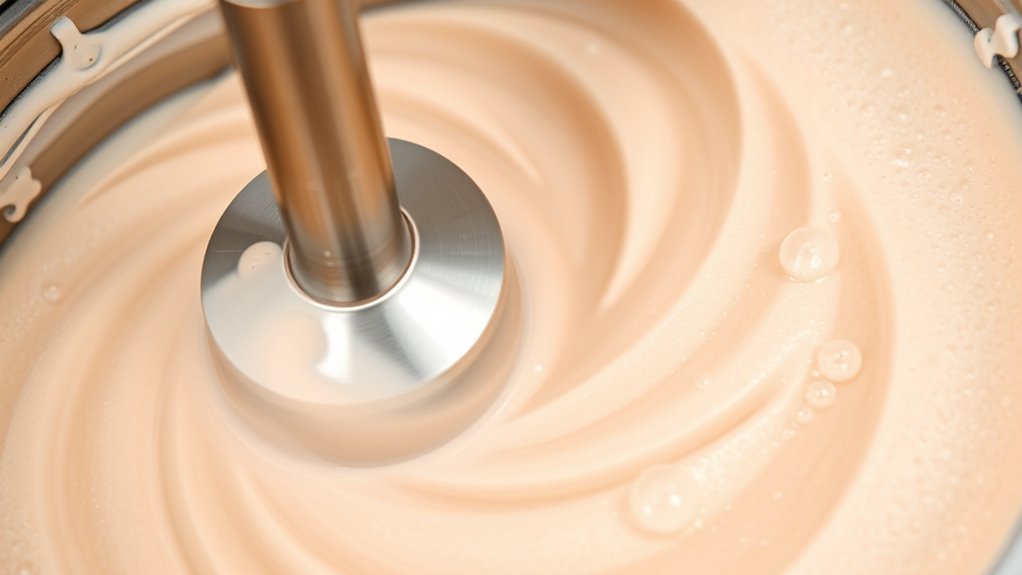
Agitation during ice cream production plays a critical role in developing its smooth texture by evenly distributing ice crystals and incorporating air. The process relies on airflow dynamics within the machine, ensuring consistent movement of the mixture. As the machine churns, blades create turbulence that affects how ice crystals form and grow, which is where material science comes into play. The properties of ingredients influence how they respond to agitation, impacting creaminess and stability. Proper agitation prevents large ice crystal formation, resulting in a velvety mouthfeel. By controlling airflow and understanding how different materials interact during mixing, manufacturers optimize texture development. Additionally, the effectiveness of agitation is influenced by the precise mechanical action, transforming a simple mixture into a luscious, smooth ice cream you love to enjoy. The tuning of the machine’s components can significantly affect the consistency and quality of the final product.
Innovations in Modern Ice Cream Machine Technology
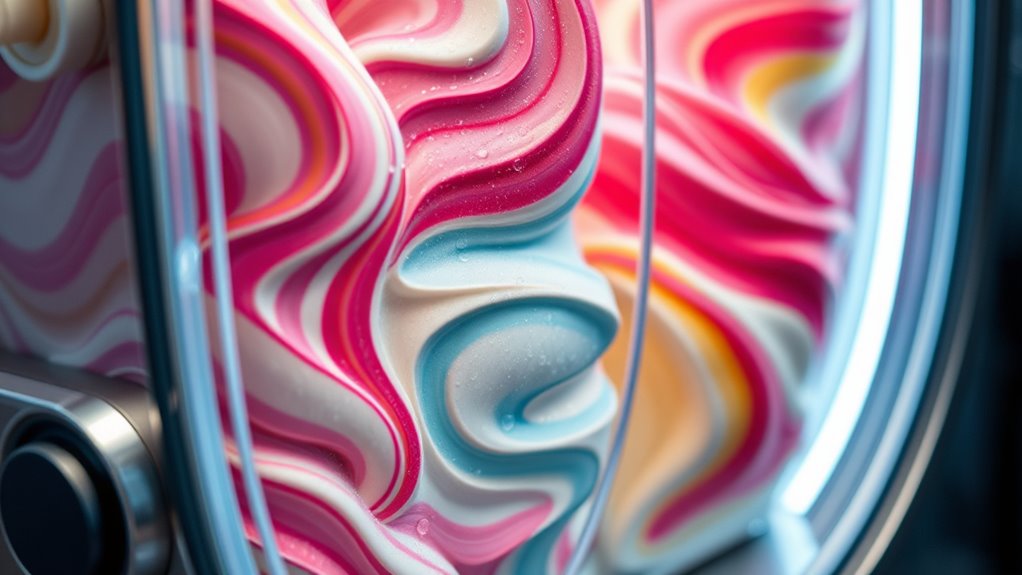
Recent advances in ice cream machine technology have revolutionized how producers create premium products. Innovative features now enable precise flavor infusion, allowing manufacturers to blend bold, complex flavors directly into the mix without compromising texture. These machines also prioritize ingredient preservation, using advanced cooling systems that maintain ideal freshness and prevent spoilage. With automated controls and improved agitation mechanisms, you can achieve smoother, creamier textures while incorporating delicate ingredients like fruit pieces or swirls seamlessly. These technological improvements reduce production time and waste, ensuring consistent quality with every batch. Additionally, ingredient preservation has been enhanced, allowing for a broader range of mix-ins and flavors to be incorporated without affecting the final product’s consistency. This advancement ensures that natural flavors and textures are maintained throughout the process. As a result, you get a more vibrant, flavorful ice cream that retains its natural essence longer. Modern innovations continue to push boundaries, making it easier than ever to craft artisanal-style frozen treats on a commercial scale.
Surprising Scientific Facts About Frozen Desserts
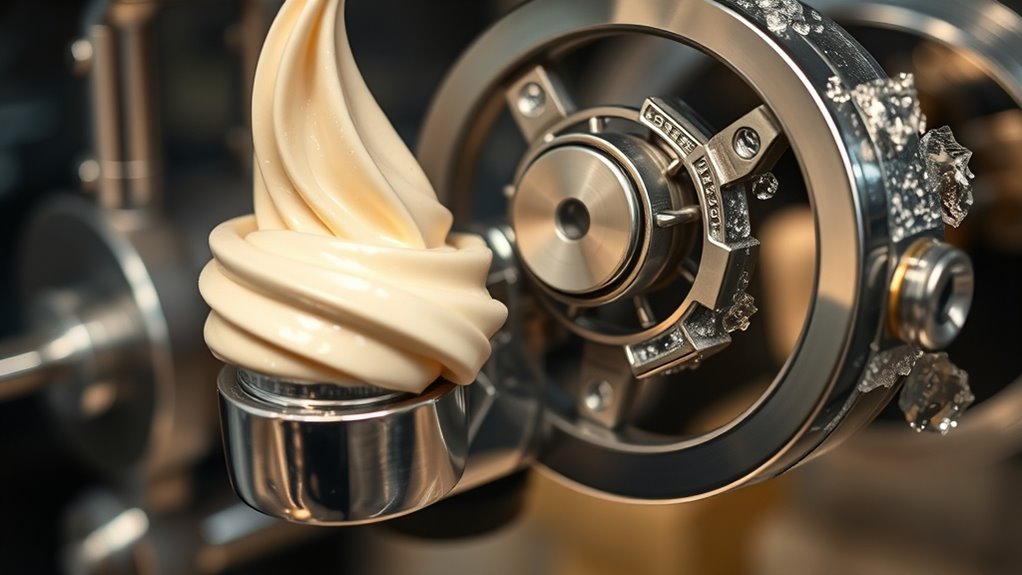
Did you know that the science behind frozen desserts reveals surprising facts about how they freeze and melt? Flavor chemistry plays a key role, as it determines how taste compounds interact during freezing, influencing flavor intensity. Sugar crystallization is another essential factor; when you freeze ice cream, small sugar crystals form, preventing larger, gritty ones that ruin texture. Controlling sugar crystallization ensures smoothness and creaminess. Interestingly, the rate of freezing affects both flavor release and crystal formation—faster freezing produces smaller crystals for a silkier feel. The physical properties of ice cream also influence how it melts and refreezes, affecting overall texture and enjoyment. Techniques like controlled freezing rates are crucial for optimizing texture and flavor during production. Additionally, understanding the crystal development process helps manufacturers improve product quality and consistency. Recognizing these scientific principles allows for better control over the final product, leading to a more delightful frozen dessert experience. For example, temperature control plays a vital role in managing crystal growth and ensuring optimal texture. Understanding these scientific facts helps create frozen desserts that are not only delicious but also perfectly textured and enjoyable.
Frequently Asked Questions
How Do Ice Cream Machines Control Air Incorporation for Fluffiness?
You might wonder how ice cream machines control air infusion for fluffiness. They use precise mixing and agitation to introduce air into the mixture, creating foam stability. By carefully managing the speed and timing of the churning process, the machine guarantees the right amount of air is incorporated, resulting in light, fluffy ice cream. This control over air infusion is essential for achieving the perfect texture and consistency.
What Role Do Emulsifiers Play in Ice Cream Texture?
Emulsifiers play a key role in ice cream texture by improving consistency and smoothness. Different emulsifier types, like lecithin or mono- and diglycerides, help blend fats and water more effectively. By stabilizing these ingredients, emulsifiers enhance texture, reduce ice crystal formation, and create that creamy mouthfeel you love. They’re essential for achieving the perfect balance of fluffiness and richness in every scoop.
Can Different Types of Sugar Affect Freezing Points?
Think of sugar as a magician’s wand, subtly influencing your ice cream’s dance on the freezing stage. Different sugars, like glucose or sucrose, can lower the freezing point, preventing sugar crystallization and keeping ice cream smooth. You’ll notice that varying sugar types change how quickly your dessert freezes and its final texture, making each scoop a unique experience shaped by the chemistry of the sugars you choose.
How Do Additives Influence Ice Crystal Formation?
Additive interactions play a key role in influencing crystal growth during ice cream freezing. When you add ingredients like stabilizers or emulsifiers, they interfere with ice crystal formation, preventing large crystals from developing. This results in a smoother texture. By controlling additive interactions, you can slow down crystal growth, ensuring your ice cream stays creamy and delightful, rather than icy and grainy.
What Are the Environmental Impacts of Commercial Ice Cream Machines?
You might wonder about the environmental impacts of commercial ice cream machines. These machines often consume a lot of energy, increasing overall energy consumption and carbon footprint. By adopting sustainable practices, such as using energy-efficient equipment and renewable energy sources, you can reduce these impacts. Implementing greener technologies helps lessen environmental harm, ensuring that producing your favorite treat is more eco-friendly while maintaining quality and efficiency.
Conclusion
Understanding the science behind ice cream machines reveals just how intricate and fascinating frozen desserts truly are. Did you know that over 1.2 billion gallons of ice cream are produced annually worldwide? This incredible quantity showcases the importance of thermodynamics, chilling techniques, and machinery innovation. Next time you enjoy a scoop, appreciate the complex science at play—it’s what makes each bite perfectly creamy and delightfully invigorating.
